eCall Pilot
Development of the Project
Dolphin Technologies, market leader in Austria for security systems and telematic units for cars, offers together with ÖAMTC and mobilkom austria products and services in terms of a strategic business network. This Product is a vehicle tracking system, which sends an automatic message to an operation centre in case of an accident or theft and contains an ermergency-button as well. Due to the initiative eSafety from the European Union, Dolphin Technologies got in contact with the Federal Ministry of Transport, Innovation and Technology in Jannuray 2006. With common planning of action the first steps of the project were defined and theron presented to the Austrian Traffic Safety Association.
Informal Meeting of Transport Ministers at Röthis
In the context of the Informal Meeting of Transport Ministers at Röthis (Vorarlberg, Austria) in March 2006 the project partners presented the functionality of eCall for the first time on such a high-ranking stage. The instant message from an accident has been demonstrated with an accident simulator.
Infrastructure of eCall Pilot Project
For the eCall pilot project the GPS Tracking System Satalarm® from Dolphin Technologies was used. This System is equpped with an external crash sensor and a red emergency button. In case of a theft the vehicle can be located at any time. The SIM-Card from mobilkom austria inside the unit ensures the communication. After triggering an alarm, the ÖAMTC operation centre get informed by two different ways. A SMS-Message, which is reformatted to an email on the IT-Platform TELECOMMANDER from mobilkom austria will be send. This email includes all relevant data regarding the driver and the vehicle as well as the position where the alarm message has been sent from. Furthermore the data of the closest PSAP is stated. At the same time a voicecall to a special telephone number of the operation centre is triggered, whereat the integrated voice processor informs about the reason of the alarm (Accident, Emergency, Theft) and the identity of the vehicle. In addition it’s possible to request the current position of the car, which is communicated using geographic coordinates.
eCall Test Drivers
The testbedding has been scheduled with 100 test drivers, to get a representative statement for the cycle of messaging. Eachone of these 100 test drivers had to trigger at least 10 alarms.The test drivers were elected out of 1.000 applicants by principle of contingency.
Installation
The installation of the eCall test units has been taken place at twelve independent garages. Those garages are trade partners from Dolphin Technologies and familiar with the installation and programming of GPS tracking systems.
Phases of the eCall Pilot Project
The eCall project has been scaled in four phases: The (1) election of the test drivers followed by the (2) logistically orgranisation including the installation, the (3) enquiry of the statistic data and (4) their evaluation and interpretation.
1. Election of the test drivers
Starting with June 2nd, 2006 the eCall pilot project has been pronounced at the homepages of the Federal Ministry of Transport, Innovation and Technology and the other project partners referencing to the webpage www.e-call.at, which has been specifically created for this project. In addition to general information about the EU-Initiative and the eCall pilot project we invited people to take part on the project and apply as a test driver (s.fig. 1). At the same time we communicated this contents by a press release and pointed out that it is possible to take part in this project via this platform. In return the test drivers might keep the systems for private use if they wanted to, or the systems were removed free of charge. The test drivers had to take no charges during the test phase resp. until August 2006. After the test the customary prices for the SIM-Card and the services of the operation centre had been invoiced.

Fig. 1: eCall Website
2. Organisation of the System Installation at the vehicles
The installation of the Satalarm systems took place in June and July 2006. Every test driver got his own log-in at the eCall internet platform where they had to fill in their personal data. Depending on the residencies of the test drivers they were assigned to one of the twelve garages. After signing the cellular network contract with mobilkom austria, they were finally authorised as eCall test drivers. The contract has already been completed with the data of the drivers, they just had to sign it and send it to the direction of the eCall project with a copy of their ID card. Thereon a Satalarm system together with the already registered SIM-Card was sent to the assigned garage, which arranged a date for installation with the test driver. In the course of installation the test driver got his eCall test driver pass as well as a eCall label for the car.
3. eCall Testbedding
After the installation of the Satalarm system the eCall test driver had to give at 10-12 test alarms, by using the emergency button, until August 11th. A simulated accident alarmed the operation centre, which had to recall the driver on the deposed cell phone number. The operation centre had to clarify if the alarm was an eCall test or a real case of emergency and if the transmitted position of the car was correct. Then the test driver had to complete his test driver pass with the time of the alarm, the time of the recall from the operation centre and the validation of the transmitted position. After completion of the required test alarms, the test drivers had to transfer the results to the eCall homepage. (s. fig. 2). The ÖAMTC operation centre logged the delay between the email alarm and the voicecall. Mobilkom austria also evaluated the incomming voicecalls and the alarms via SMS.
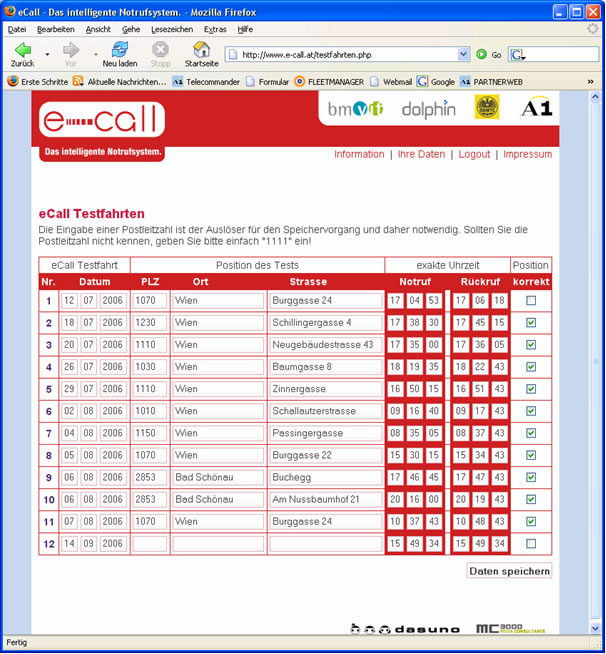
Fig. 2: eCall Website
4. Test Driver Questionnaire
An anonymized online-inquiry took place at the beginning of September,
to regard also aspects of implementation of the project. Via email the 100 test drivers were asked to fill in a questionnaire on the internet.
This also detected the quality of the project. The results are not mentioned within this document, because they just serve the internal quality control of the collaborating project partners.
Technical Cognitions and Interpretations
Verifying the reliability and the velocity of the incomming emergency message has been a very important aspect. The used standards at this pilot project, which were transmitting via SMS on the one hand and the standard voicecall on the other hand, can be exposed to be very effective. There is a marginal potential of optimising the chain of massaging between GSM provider and the operation centre. The test result shows, that 72 percent of the alarm messages were answered within two minues. Further twelve percent in the third and fourth minute after alarming. In the case of emergency the accurate help could have been on the way only after four minutes.
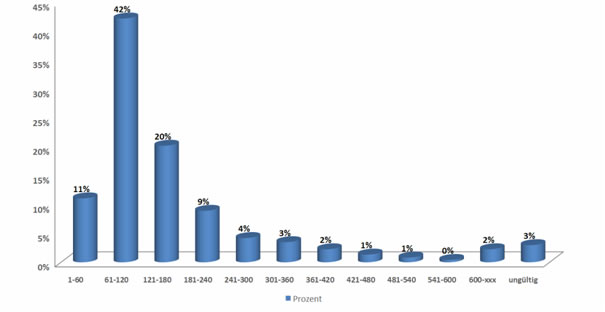
Fig. 3: Answering time in seconds
Generally speaking, both the voicecall and the SMS are valid instruments for transmitting emergencies. Nevertheless, there are pros and cons of both, which are considered in the next chapters.
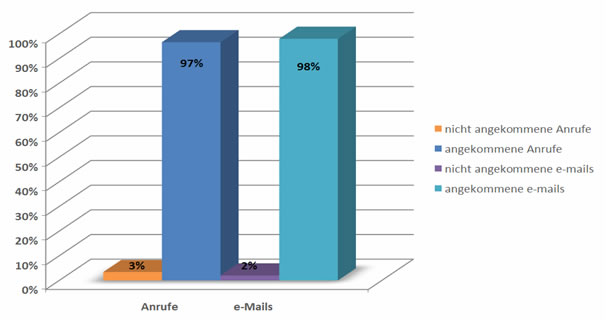
Fig. 4: Reliability of Voicecall vs. SMS/Email
1. Voicecall as an Alarm Medium
The advantage of an accident message via voicecall is, that it’s not nesessary to have a SIM-Card installed for an emergency call to the emergency number 112. Originating from the current technical structure of the emergeny centres a system would be required, which initiates a voicecall to 112 and advises the coordinates of the accident using a voice processor. A web database with connection to a mapserver would enable the emergency centre to clarify the identity of the owner as well as the cars position. But on the other hand it’s debatable, if a voicecall, after an accident with a significant physical damage of the car, could be guaranteed. In addition to that, a system like that will be unsuitable for other services like theft tracking, breakdown serve, etc..
2. SMS as an Alarm Medium
For transmitting a SMS-Message it’s necessary to have SIM-Card installed. As a consequence the provider’s costs have to be refunded by a basic fee or other ways of revenue. The advantage of SMS, is that you need less GSM reception than for a voicecall. Furthermore it is rather ensured, that the alarm can be sent, in consideration of the damaging of the vehicle caused by an accident. In addition this way of transmitting enables the integration of external operation centres at this stage.
3. Social Cognitions and Interpretations
The driver and his acceptance will be the most important aspect during the implemantion of eCall in Europe. As by today it’s not clear who is going to pay for the establishment of the hardware, the services and the infratructure behind eCall, another important question has been, if and in which dimension drivers are willing to bear expenses and if they are interested in other services.
4. Willingness to bear the expenses
More than 60 percent of the elected test drivers agreed to pay between EUR 9,00 and EUR 14,00 per month to get prompt support in case of an accident or an emergency. Almost the half were moreover willing to pay at least EUR 300,00 for the hardware and the installation. From a manufacturers point of view the threshold of costs can be fixed at EUR 900,-. This shows clearly, that road traffic security, got such a high importance for drivers, that they are willing to pay for it.
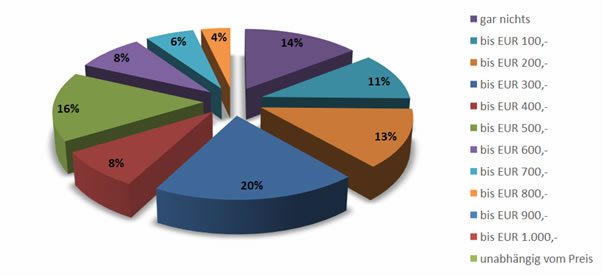
Fig 5: What amount is acceptable for hardware and installation?
5. Interest in advanced Services
Particularly mobility services and traffic information, as well as navigation are interesting for drivers. Economic potential exists also for other services. In that respect it seems to be important to include mobility service providers to the infrastructure of eCall, in order to achieve cost recovery.
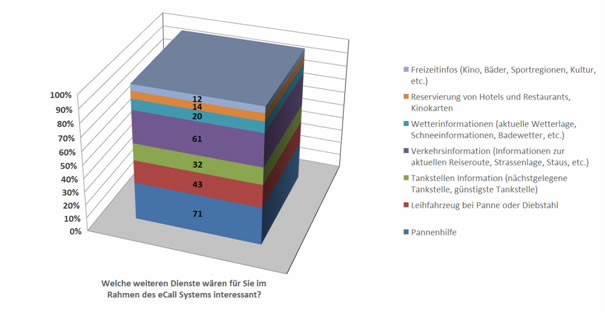
Fig. 6: Which additional services would be of interest?
6. Information over Velocity
The summary of statements of emergency physicians is, that the quality of the information transfer respectively the content of the emergency message is at least as much important as the velocity of the messaging.
On the part of medical science – appart from bagatelles – it is important to distinguish between the following situations:
- Acute life-threatening emergencies (bleedings, shortness of breath, heart attack, apoplexia respectively external circumstances like fire, danger of drowning, etc.)
- Non serious endangering emergencies, at which the degree of consequential damage, caused by extension of the duration until the assistance after accident, increases respectively turn into a deathtrap (bruised bodily parts or mutilated extremities, etc.)
Special attention should be paid to the information content, as it was pointed out again and again in the conversations with the medical doctors. Among the structure of the transmission, this aspect is also highly important for the choice of transmittance media for emergency messages and for the supporting data source.
Prospect
The implementation of eCall in terms of an european concept implicits not only the involvement of the telecommunication- and automotive industry, the Ministries of Transport and the Ministries of the Interior of the european member countries, but also the insurance industry. It also should be considered whether the present infrastructure of operation centres in Europe is sufficient to perform these services. As soon as an emergency button will be part of the package, the involvement of a clearing house will be an essential precondition for the implementation of eCall. Considering the multilingualism in Europe,it would be preferable and advisable to have a contact person to converse with in the national language of the casualty. Furthermore it is possible to create business-cases, to induce drivers to cost sharing in terms of a quick implementation. With this pilot project and also with the systems which are already on the road, Austria demonstrated that it is prepared for eCall and take the request from the European Union seriously, by making an important contribution for the security on the road.
